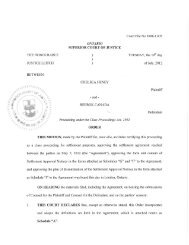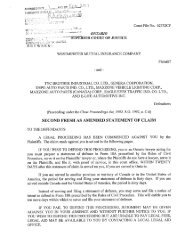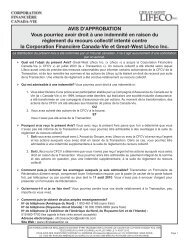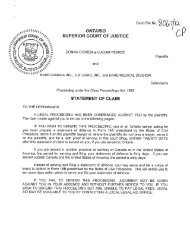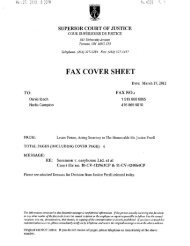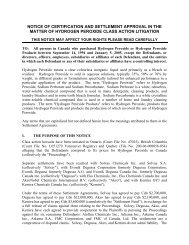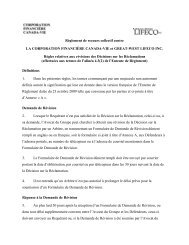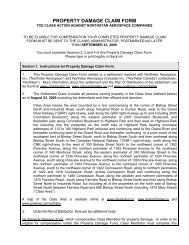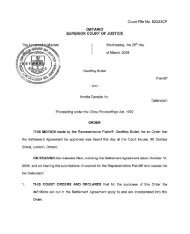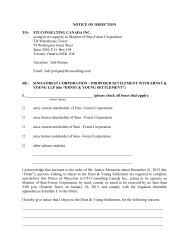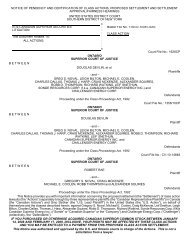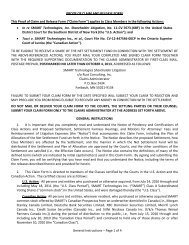Gariepy v. Shell Oil Co. - Classaction.ca
Gariepy v. Shell Oil Co. - Classaction.ca
Gariepy v. Shell Oil Co. - Classaction.ca
You also want an ePaper? Increase the reach of your titles
YUMPU automatically turns print PDFs into web optimized ePapers that Google loves.
include persons who do not have a claim be<strong>ca</strong>use they either have not experienced any loss orbe<strong>ca</strong>use the loss experienced is restricted to the plumbing system itself. 30 On the duty of <strong>ca</strong>re issue, Celanese relies on Harrington v. Dow <strong>Co</strong>rp. (1996), 48 C.P.C. (3d)28 (B.C.S.C.), aff'd. (2000), 193 D.L.R. (4th) 67 (B.C.C.A.) and Harrington v. McGhan Nusil <strong>Co</strong>rp.,[1999] B.C.J. No. 250 (C.A.) in support of its assertion. 31 I believe that Celanese has misinterpreted the conclusions in those two <strong>ca</strong>ses. Those <strong>ca</strong>ses dealtwith a situation where a party took someone else's product and incorporated it into their product ina manner that <strong>ca</strong>used the final product to be defective. In other words, it was the design, and not theincorporated product, that was defective. It was not a situation, as is the <strong>ca</strong>se here, where theplaintiffs say that the defendants' products were themselves defective for use in the final productregardless of the design. Rather, the plaintiffs allege that the defendants manufactured products thatthey knew, or ought to have known, were not suitable for use as an ingredient in the manufactureof products that were, in turn, to be used in potable water systems. The plaintiffs further allege thatthe defendants were negligent in putting such products into the marketplace knowing they wouldbe used in the manufacture of such products. 32 In my view, given the nature of the allegations made, the statement of claim discloses a proper<strong>ca</strong>use of action in negligence against the defendants. 33 Having reached the conclusion that there is a proper <strong>ca</strong>use of action alleged against thedefendants in negligence, I must nonetheless consider whether the other <strong>ca</strong>uses of action areproperly alleged. While I appreciate that section 5(1)(a) refers to the pleadings disclosing "a" <strong>ca</strong>useof action, I do not interpret that section as meaning that only one <strong>ca</strong>use of action need be establishedand then the other <strong>ca</strong>uses of action alleged <strong>ca</strong>n just piggyback on that <strong>ca</strong>use of action. Not only itis necessary to demonstrate a <strong>ca</strong>use of action against each named defendant (see Ragoonanan Estatev. Imperial Tobacco Canada Ltd. (2000), 51 O.R. (3d) 603 (S.C.J.)), in my view, it is also necessarythat every <strong>ca</strong>use of action alleged against a particular defendant be demonstrated. This is necessaryfor a number of reasons. First, a defendant should not be subject to any claim, particularly oneasserted on behalf of a whole class of plaintiffs, which does not disclose a proper <strong>ca</strong>use of action.Secondly, all of the claims asserted in the statement of claim impact on the question of whether thereare common issues. I do not believe that a plaintiff <strong>ca</strong>n purport to set up common issues based on<strong>ca</strong>uses of action that are not properly pleaded. Thirdly, the nature of the claims advanced very muchdetermines the proper members of the class. In other words, if certain claims are eliminated be<strong>ca</strong>usethey are based on non-existent <strong>ca</strong>uses of action, various individuals who might otherwise bemembers of the proposed class would be removed as class members. As I will deal with furtherbelow, it is important that the definition of any class not be overly inclusive, that is, the class shouldnot include persons who do not have a claim - see Moutheros v. DeVry Canada Inc. (1998), 41 O.R.(3d) 63 (Gen. Div.) at p. 73. 34 The defendants assert that the <strong>ca</strong>uses of action alleged in misrepresentation and breach ofwarranty <strong>ca</strong>nnot survive even minimal scrutiny. It does not appear to be disputed that the materialfacts required for these <strong>ca</strong>uses of action have been properly pleaded. The defendants, however, saythat, as a result of the cross-examinations that have taken place, each of the representative plaintiffshave expressly disavowed relying on any representations and have also admitted that they did notreceive any information in the nature of a warranty upon which they relied. The defendants therefore



